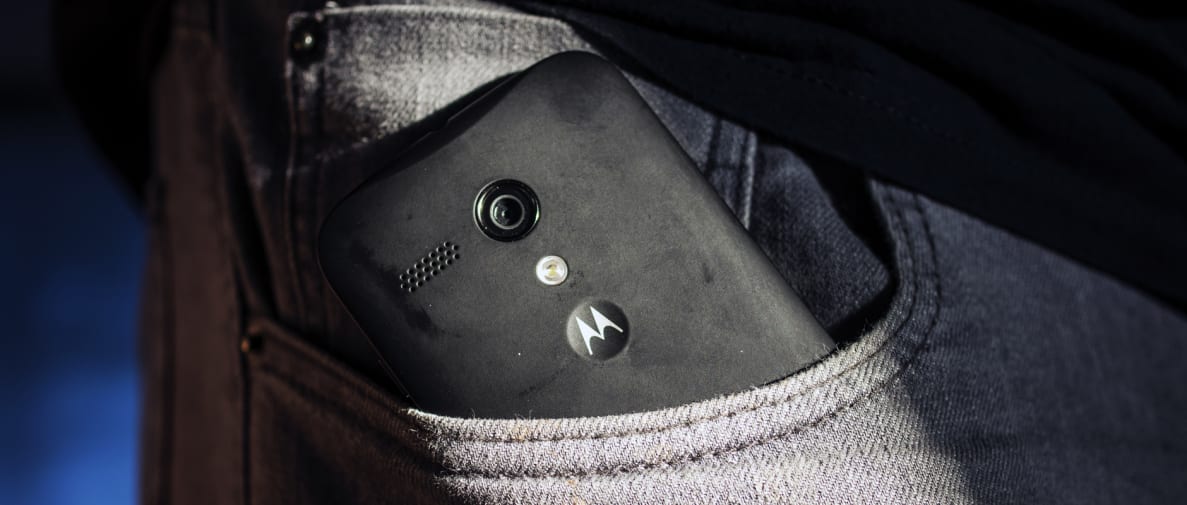Take smartphones, for example. Until just recently a decent full-priced smartphone would run you $700, leaving you to stick with dumb, feature-less phones or sign up for a two-year contract. Phones like the Motorola Moto G with LTE (MSRP $219.99 unlocked) are here to change that.
Though it's not the best phone, the Moto G's got very respectable hardware with Motorola cutting only the slightest of corners. Not only does it have the performance to hang with higher-end phones, it's got killer battery life, a durable design, and a pretty nice screen.
This phone isn't cheap, it's affordable.
Design & Usability
A no frills, fully-loaded bargain phone.
When you first pick up the Moto G, you'll notice that it feels more solid than most cheap phones. It's plastic, but it doesn't bend or feel like it's going to shatter if you drop it. It has a soft-touch backing that's actually quite a joy to hold, even if it doesn't scream "premium" like aluminum phones from HTC and Apple. And bucking the trend of smartphones that are obsessed with their waistlines, the Moto G has some thickness and a few curves to it—which is just more of the phone to hold onto.
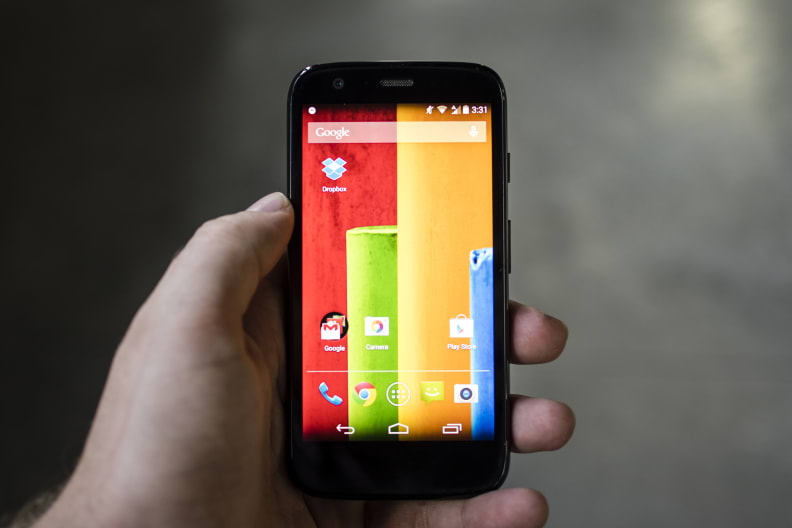
The Moto G is as simple as it gets.
Running the latest version of Android 4.4—and getting fast updates to boot—you'll never have to miss out on the latest Google's innovative OS has to offer. On top of that, an LTE radio (you can shave the price down to $179.99 if you go without it), Bluetooth 4, an 802.11n wireless card, and a standard microUSB port all work together to ensure you have the latest connectivity options. There's no NFC chip, but it's not a huge tradeoff considering the price you pay for the phone—it's like buying a new car for one third the cost and only sacrificing power windows.
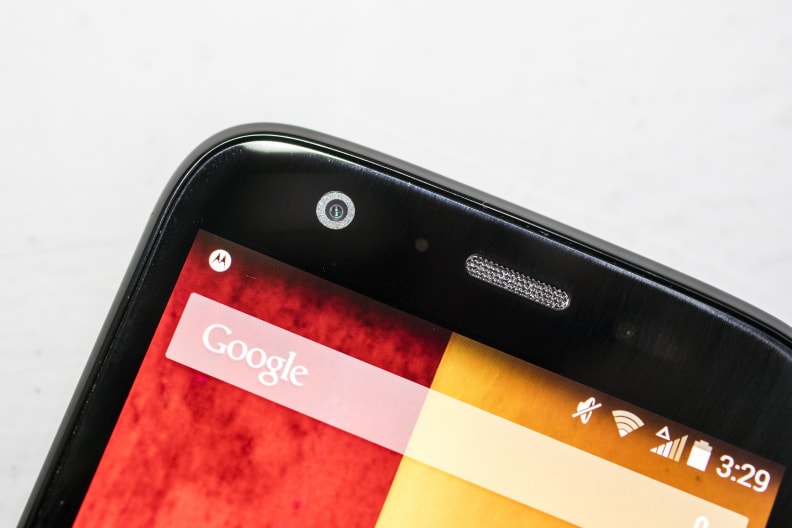
A front-facing camera allows you to video chat.
Behind a layer of the newest Gorilla Glass is a capacitive touchscreen and a 720p LCD. Considering that the screen is only 4.5 inches, that's good for a pixel density of 330ppi—basically identical to the iPhone 5S and easily surpassing the arbitrary "Retina" standard.
The lean hardware under the hood may not be all that inspiring, but the situation is much better than it sounds. For example, the Snapdragon 400 processor and only 1GB of RAM seems very underpowered, but operation of the device is still snappy. Google's "Project Svelte" initiative cut the memory usage of most Android apps in 4.4 KitKat, meaning the G can get by with a relatively limited pool of RAM. Having only 8 to 16 gigabytes of internal storage also is a bit of a drag, but the 4G LTE variant of the Moto G has a microSD card slot, letting you add another 32 gigabytes of storage.
{{ photo_gallery name="tour2" }}
Because the version of Android on the Moto G is almost as pure as you can possibly get, there's a very uniform interface. Controls and navigation are very easy, and it takes only a little effort to find what you need—even if you get a little lost. Additionally, all Google services and just about every app on the Play Store will work on this phone, so if you're looking for a phone that'll work well enough and never leave you wanting, the Moto G's got you covered.
Performance
It's not good for the price. It's just good.
Now, not to temper all the excitement we just built in the intro, but the Moto G doesn't have that crazy of a spec sheet. Motorola aren't miracle workers. But like an experienced thrift store shopper, Motorola knows where the value is. Though it doesn't really excel in any one area, this phone is much greater than the sum of its parts.
Once you power on the phone, you won't find any carrier or manufacturer pre-installed bloatware. No redundant apps, no annoying system apps that can't be uninstalled, no wasted space on the drive. Considering the aforementioned lack of expandable storage, this is a godsend. It's exactly why in some ways, even the lowly Moto E performs better than the Samsung Galaxy S5.
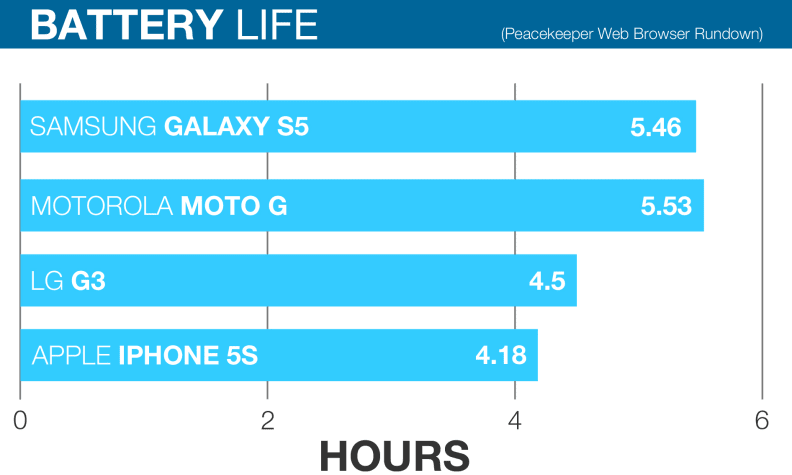
The Moto G has the best battery life we've seen so far under extreme web browser load.
Of course, when the G is given a single, processor-intensive task, it just doesn't keep up with flagship-level hardware. That's to be expected. If you're playing high-end Android games or streaming video, the G may not cut it. However, when it comes to things like basic graphics, web browsing, and low-load operations, the G hangs tough. Though it may never compete with the Samsung Galaxy S5 or LG G3 in overall horsepower, the Moto G runs pretty smoothly during everyday operations.
And while the processor and screen on the Moto G aren't perfect, there's a benefit to that: battery life. The G's 2070mAh battery is non-removable, but it lasts just as long as the much larger batteries in the LG G3 and Galaxy S5. In our labs, it took over 5 and a half hours of extreme load to run down the battery—more than a full hour beyond the LG G3 and on par with the Galaxy S5.
A big part of that is the smaller screen, just 720p, but is actually a high-quality HD panel. Not only does it have a very accurate color gamut along the Rec. 709 standard—the international standard for HDTV color performance—but it also has a near-perfect transition from black to white (2.21 gamma). The LCD isn't quite as bright as the iPhones of the world, though, so visibility in direct sunlight isn't the best.
Camera
If there's a catch, photography is where you'll find it.
The point-and-shoot camera market has been imploding in the last couple years because, for day-to-day snapshots, most people just rely on their smartphones. Despite this fact, smartphone cameras are still pretty poor compared to even basic dedicated cameras. That's usually okay, though; what makes for a good Instagram shot can still look terrible on a 4x6 or 8x10 print.
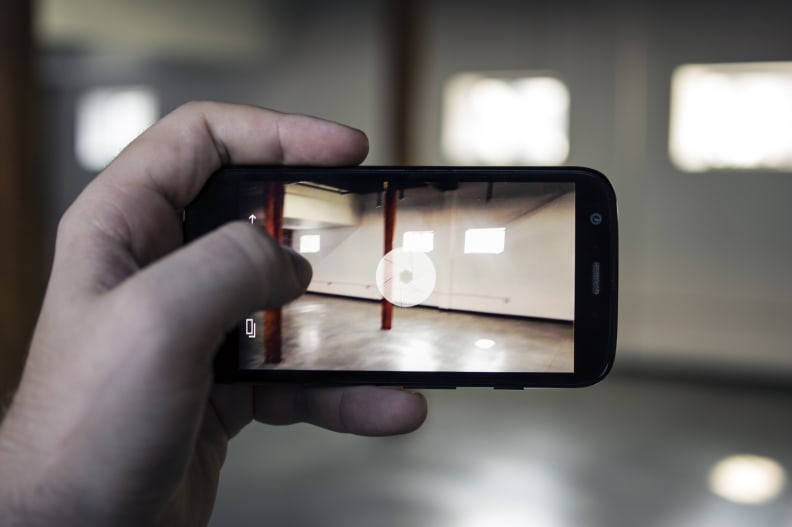
Tapping the screen in the default camera app snaps a picture, not autofocus.
Even the best smartphone cameras have wild color error, terrible sharpness, abysmal dynamic range. Unfortunately for the Moto G, it doesn't even do well by the low standard other smartphone cameras have set.
For starters, a color error (∆C00 saturation-corrected) of 3.55 is far beyond what we'd consider acceptable for a dedicated camera. Reds are pushed too far, while yellows and greens just don't pop as much as you'd expect them to.
Sharpness, too, is fairly wretched. Though it's not the worst smartphone camera we've tested—that honor belongs to the Moto G's little brother, The Moto E—you can expect to see a certain fuzzy quality to your shots if you ever check them out at full magnification. Only being able to resolve an average of 952.9 lw/ph even in ideal conditions is terrible no matter how you slice it.
The Moto G's camera doesn't add in much noise, but that's largely due to a sinister tradeoff. Shots you take with the camera will lack noise because the camera's software automatically applies a heavy-handed noise reduction algorithm, killing fine detail in the process. Considering how fuzzy the camera's photos are to begin with, low light will ruin nearly shot you take.
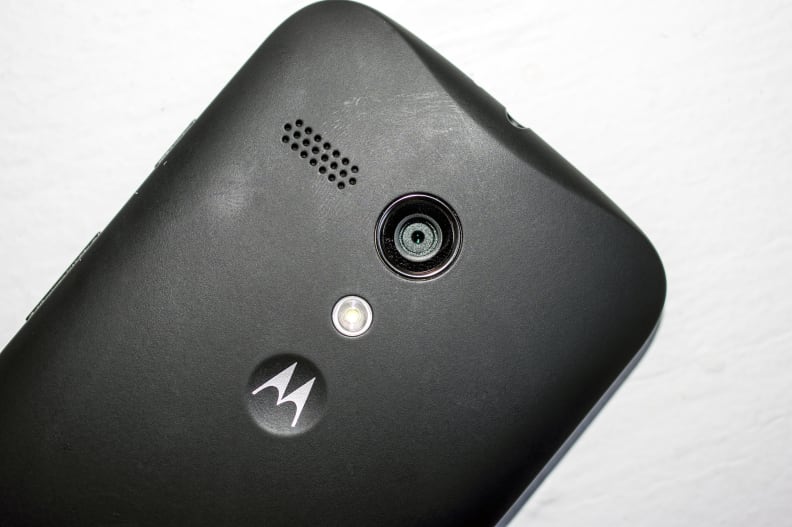
Don't let its aesthetics fool you, this camera is very bad.
All these problems and more combine to ensure especially low quality video. Whether it's in low light or bright light, your clips will look fuzzy and out of focus with loads of compression artifacts. In general, the Moto G's shots will look fine on Facebook or in a quick Vine, but if you are capturing a special moment we highly recommend you use a better camera.
{{ photo_gallery "sample-photo" }}
Conclusion
Being cheap is no longer an excuse.
I've said it before, and it bears repeating: The Moto G is far more than the sum of its parts, and there's good reason that it's the most popular Motorola handset of all time. Not only does it hang tough with the rest of the market, but it doesn't load you up with junk you don't need. It's perfect for anyone who needs a good smartphone and might be a little hesitant to make a huge investment into a device they'll wind up replacing in a year anyway.

Android can use any one of several keyboards with innovative input methods.
Because this phone is offered off-contract, the sticker price might sting a bit at first. However, it does unlock the world of pre-paid contracts—which will let you pay far less a month for the service you need. When you consider that you're not locked into a carrier, or even have to pay off the device—that $219 winds up being the smart money investment in a short time.
Taken at face value, this smartphone has an awesome screen, outstanding battery life, and a simple-as-you-like user experience. It's one of those phones that you'll look back to in five years and wonder why they aren't still being made. Sure, it's not the best device out there, but it runs like a dream and won't put you in the poor house. It might be an entry-level phone, but that doesn't mean it isn't a great device.
To be perfectly blunt, there isn't a better value on the market today. That might change with new phones being announced in the coming days, but that might drive down the price of the Moto G even more. For what you're getting, the Moto G's price is a paltry sum to pay. If you really only need a basic phone to check email and browse the web, you might find the Moto E to be a better value. But it comes at the tradeoff of a near-unusable camera, worse performance across the board, and only a savings of about $50.
Obviously, if you need to have the latest apps, NFC, or best camera—you don't want the Moto G. However the line that distinguishes good smartphones from entry-level ones is really not that definitive. A great smartphone will still have a crappy camera for the time being, and the importance of practical measures like battery life can't be oversold. By that token, the Moto G is an incredible phone, and the one to buy if you need a basic smartphone sidekick.
Meet the tester
A seasoned writer and professional photographer, Chris reviews cameras, headphones, smartphones, laptops, and lenses. Educated in Political Science and Linguistics, Chris can often be found building a robot army, snowboarding, or getting ink.
Checking our work.
Our team is here for one purpose: to help you buy the best stuff and love what you own. Our writers, editors, and lab technicians obsess over the products we cover to make sure you're confident and satisfied. Have a different opinion about something we recommend? Email us and we'll compare notes.
Shoot us an email


